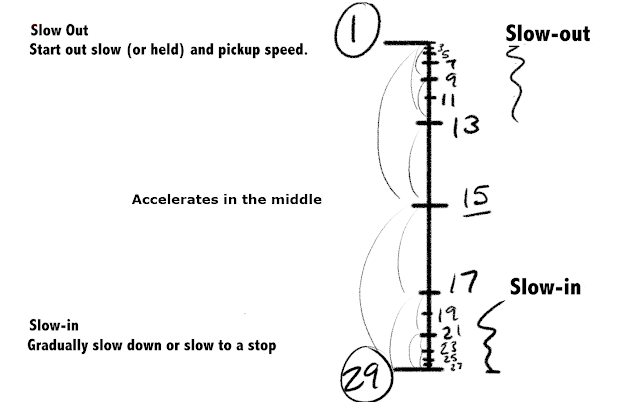SLOW-OUT AND SLOW-IN
As action starts, we have more drawings clustered near the starting pose, fewer drawings in the middle of the action as the action accelerates, and more drawings clustered near the next pose. Fewer drawings make the action faster and more drawings make the action slower. Slow-ins and slow-outs soften the action, making it more life-like. For a gag action, we may omit some slow-out or slow-ins for shock appeal or the surprise element. This will give more snap to the scene.
The Principle of "Slow-Out" and "Slow-In" is difficult to isolate as a specific principle apart from the others ... you'll see slow-outs and slow-ins used constantly in full character animation.
Here's an example I used above to show overlapping action , but it also shows SLOW-IN . As Minnie Mouse enters the scene she is moving at full speed , then as she looks and sees something off-screen she slows-in to the pose where she looks ... then she does a quick reaction as she jumps back in surprise , and then slows-in to the final pose :
Again, with an example used above , Tillie the tiger blows out the candles on her birthday cake . As she goes from her first pose up into the anticipation pose (inhale) she slows-out of the first pose , slows-in to the inhale , then as she moves forward into the pose blowing out the candles she slows-in to the last pose:

Sophisticated use of the "Slow-Out/Slow-In" principle can be seen throughout this animation of the 7 Dwarfs (by Frank Thomas) as they sneak into the bedroom, thinking there is a monster in their bed. Notice Slow-out and Slow-in on the careful sneak action , then Slow-in as they draw back in surprise at around the 0:08 - 0:09 mark , then again at the end as they raise their tools getting ready to attach the "monster" , but then lower them as they realize that it's a girl in their bed , not a monster.
--------
This example from "The Animator's Survival Kit" by Richard Williams shows SLOW-OUT and SLOW-IN . Notice the inbetween spacing chart at the beginning of the action from Pose (A) to Pose (B) has many more drawings clustered closer to the start drawing A (this is SLOW-OUT) and at the end of the action there are many more drawings clustered around the end position B (SLOW-IN) .

(notice Richard Williams refers to this as "Cushion-In" . "Cushion-Out/Cushion-In" is synonymous with "Slow-Out/Slow-In" . Sometimes aka "Ease-Out/Ease-In" . Also notice he's discussing a further refinement of the "Cushion-In/Slow-In" principle by using a "MOVING HOLD" , which is the use of a third extreme (C) to keep the figure alive and moving , but still retaining the basic pose as at (B) , so instead of Slowing-In to a full hold at (B) we keep the figure continuing back slightly into (C) with additional closely spaced inbetweens. This is a known as "Moving Hold" .)
---------
In it's most basic form , the principle of Slow-Out /Slow-In can be seen in this example from "The Animator's Survival Kit" using a coin to show the difference between Even Spacing and Spacing that has Slow-Out and Slow-In :

In both these examples the Starting Position of the Coin and the End Position of the Coin are exactly the same , and it takes exactly 24 frames for the coin to move across in both examples , BUT notice how much different the action is withe the coin SLOWING-OUT at the start and SLOWING-IN at the end of the action and vice-versa as the action repeats in reverse , in a loop.
Version 1 NO Slow-Out or Slow-In -

Version 2 - With Slow-Out and Slow-In -



No comments:
Post a Comment
Note: Only a member of this blog may post a comment.